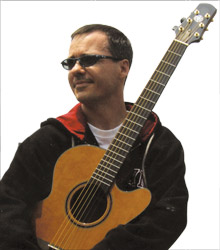 One of these days, I’ll have an intern go down to Bull Moose and take an inventory: Just what percentage of albums feature a guitar on the cover? It’s a staple of the singer/songwriter design handbook. “If possible,” reads section 16, paragraph 2, “get somebody hugging the guitar on the front. If no such photo is available, have an artist draw the guitar so that it appears like a toy.”
One of these days, I’ll have an intern go down to Bull Moose and take an inventory: Just what percentage of albums feature a guitar on the cover? It’s a staple of the singer/songwriter design handbook. “If possible,” reads section 16, paragraph 2, “get somebody hugging the guitar on the front. If no such photo is available, have an artist draw the guitar so that it appears like a toy.”
Mike Golay, a relatively new Portland-area resident from New York, has followed the letter of this handbook closely. Despite appearances, however, he’s not really what I’d call a singer/songwriter, in the end (unlike, say, Carll Wilkinson, who went with the toy guitar drawing with his Pomegranate from early 2005, or Jud Caswell, who hugged a guitar while being reflected in salt water on the cover of 2004’s Lost & Found).
Christ, Golay doesn’t even sing.
For some reason, I didn’t see that coming. After watching him try single-handedly to keep Youngo’s open over in Bramhall Square, I had him pegged as your standard coffee-shop balladeer. Instead, he’s a virtuoso-level fingerstyle guitarist, and his Across the Bridge is a robust 18 songs’ worth of some serious playing. How serious? On four of the songs he’s paired with Al Petteway, a fingerstyle legend who with Ed Gerhard and others won a 2005 Grammy for the Henry Mancini fingerstyle tribute Pink Guitar.
Okay, so on two of those tracks, including the opener, “Somewhere I Have Never Traveled,” Petteway is actually doing some kind of percussion thing with the body of his guitar (Golay, in one of many tongue-in-cheek nods in the liner notes, refers to it as “guitdrum”). But on “Welcome to Funkstown,” one of the few toe-tappable pieces here — with a solid low-end, and an almost wicka-wicka vibe from another accompanying guitarist, Alphonso Brown — Petteway contributes to the best song on the album. At about 1:40, Golay (I’m assuming) rips a scale going up that’s really hot, and then gives a bluesy solo some room to breathe. Golay here seems to be reveling in not being the only one playing, which is understandable. This whole solo fingerstyle guitar thing must be fairly exhausting, worse maybe than singing.
It can certainly be exhausting to listen to. What starts out as soothing, quiet guitar expertly picked, with bass lines supported by high-end runs, by the end of the hour of songs becomes a chore when you’re listening on the headphones. I became anxious, like I just ate a candy bar and then had to sit still for a while. All those notes, all the time, for a solid hour straight. A million paper cuts.
Well, it’s not that bad, obviously. It’s great for a quiet dinner and drinks, or for background music when you’re reading, but it just can’t quite be the center of attention for its entirely. If this were cut in half? The nine standouts? Then I think it’s a powerhouse and enviable display.
What would I pick? “Damhsa Na Saoirse” would make the cut, with harmonics and an all-stop about half-way through, the bass string walking up by itself around the 2:15 mark. Nine of Golay’s songs are, like “Damhsa,” within 15 seconds of 3:30, the standard pop-song length, which gives you a clue to where some of his songwriting tendencies might come from, but it also leads one to wonder if part of the equation isn’t just getting to three minutes and then ending it. He does do the verse-chorus-verse thing, but there often isn’t a melody line to follow, like jazz’s instrumentals will often feature. Rather, he features a series of phrases.
On the album’s longest, “Reunion March,” we get some really difficult stuff, reaching all over the neck, hitting frequent harmonics, at one point hitting one per measure. Like “Maine Waltz,” however, it’s hardly recognizable as its title form. On “March,” I think you can tap out the 3/3 time, but it’s kind of awkward.
Hard-core guitar nerds will be listening for a variety of tunings, open and capoed, and harder-core nerds will know what’s special about “Between the Rains,” which features a resonator, or more specifically a mahogany Weissenborn Style 3 copy by Gold Tone, played with a slide on at least some of the strings. It gets pretty rockin’ for about 10 seconds at the one-minute mark and again at two, after which Golay grinds to a halt, pauses, and starts over. Often, his halts act as mini bridges.
As with “Across the Bridge,” the song/story of his proposal to his wife on the Brooklyn Bridge, it seems like many of these songs are infused with emotion and special meaning for Golay that may not totally translate to the listener. I found myself desperate for a cool off-note like the one featured early in “Anam Cara,” a dissonance that gives the listener something to grab onto and mull over. Otherwise, things blend together, which keeps a good album from being great.
Mike Golay | May 4 | O’Natural’s, Portland | May 16 | Top of the East, Portland
On the Web
Mike Golay: www.mikegolay.com
Email the author
Sam Pfeifle:sam_pfeifle@yahoo.com